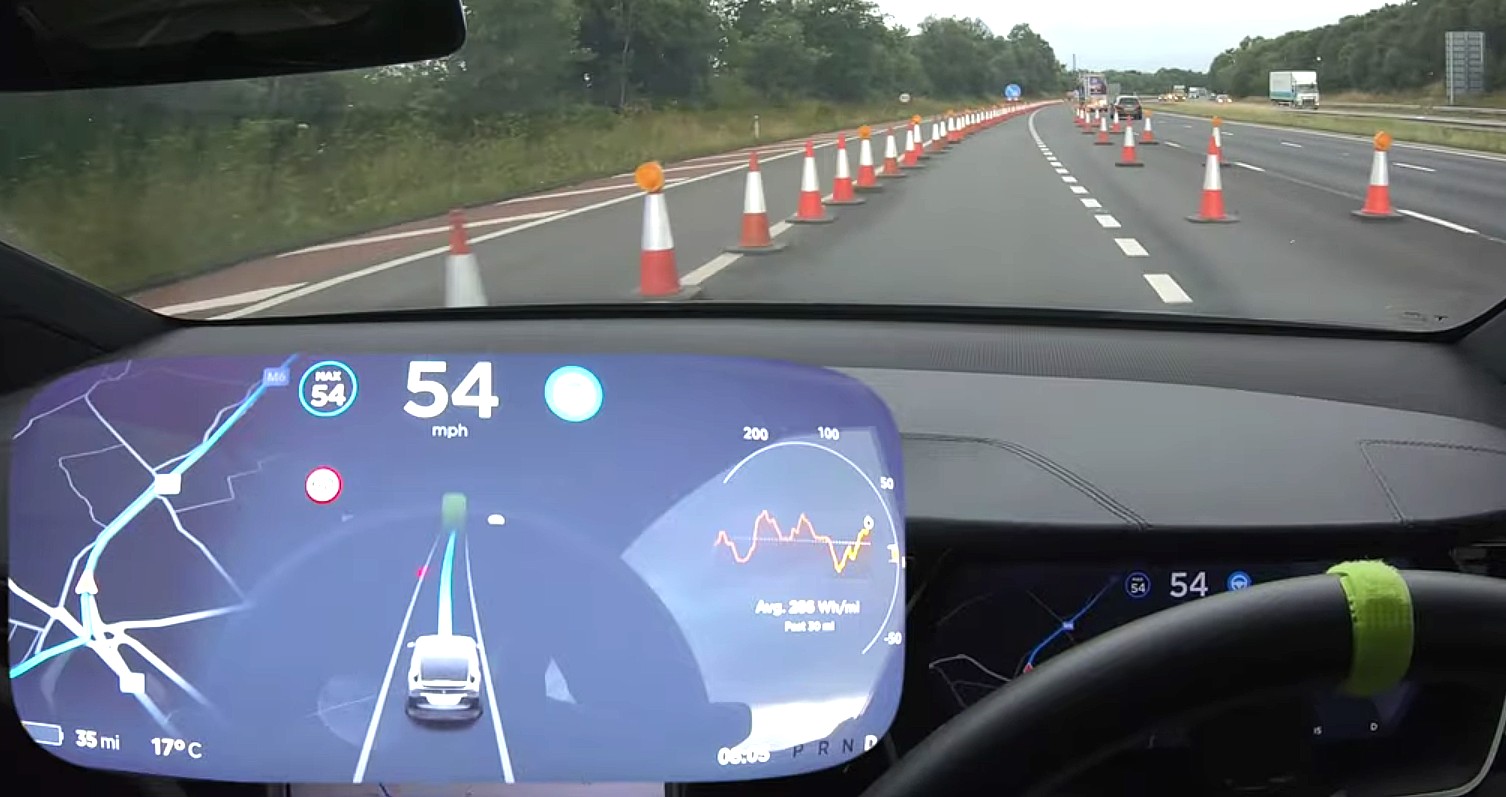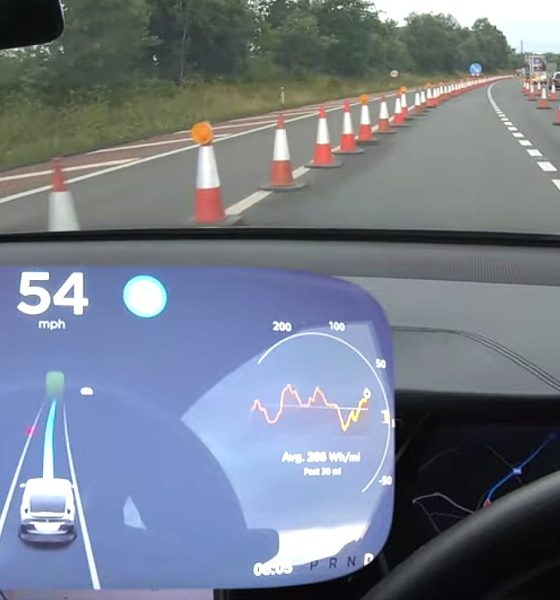

News
Tesla Autopilot makes automatic lane change to avoid construction zone
Tesla’s Full Self-Driving suite continues to improve with a recent video showing a Model 3 safely shifting away from a makeshift lane of construction cones while using Navigate on Autopilot.
Tesla owner-enthusiast Jeremy Greenlee was traveling through a highway construction zone in his Model 3. The zone contained a makeshift lane to the vehicle’s left that was made up of construction cones.
In an attempt to avoid the possibility of any collision with the cones from taking place, the vehicle utilized the driver-assist system and automatically shifted one lane to the right. This maneuver successfully removed any risk of coming into contact with the dense construction cones that were to the left of the car, which could have caused hundreds of dollars in cosmetic damage to the vehicle.
@TeslaPodcast @ResidentSponge Autopilot getting more features to improve navigation through construction. pic.twitter.com/rXgoI3Xzoi
— Jeremy Greenlee (@JeremyGreenlee) June 23, 2020
The Model 3 advised Greenlee that it would be shifting lanes by showing a message that indicated, “Changing lanes away from cones. Use turn signal to cancel.”
Although the Model 3 was operating on Autopilot and was a fair distance from the construction barriers, the vehicle made the appropriate decision to shift away from the obstacles.
Unexpected things frequently happen on highways due to high speeds of travel and other vehicles being present. Even though Greenlee’s Model 3 was not in the direct vicinity of any other vehicle, it is possible that one of the cones could have been hit by another car and could have entered the highway. Suddenly obstructing a lane on a road while vehicles are traveling at high rates of speed is extremely dangerous. However, the cones are necessary for separating traffic from the construction projects that are taking place.
Tesla has worked diligently on improving Autopilot’s performance through construction zones. In November 2019, the electric automaker’s 2019.36.1 software update started rendering traffic cones in the Driving Visualization feature. The addition of traffic cones was a focus of CEO Elon Musk, who wanted to add the construction barriers as an additional piece of information for Autopilot to consume.
Several videos of Tesla Autopilot-enabled vehicles navigating safely and impressively through construction zones have surfaced. The performance of cars that use Autopilot has continued to improve through construction areas thanks to the accumulation of data that is transported to Tesla’s Neural Network, along with software improvements that work toward the company’s release of a “feature complete” Full Self-Driving suite.
The continuing release of Autopilot improvements that Tesla gives to its fleet with each software update work toward safer driving environments for everyone on the road. While the company aims to continue making strides toward the release of its completed FSD suite, the vehicles are becoming more accurate and calculated with their recognition of objects in the road ahead.

News
Nvidia CEO Jensen Huang explains difference between Tesla FSD and Alpamayo
“Tesla’s FSD stack is completely world-class,” the Nvidia CEO said.

NVIDIA CEO Jensen Huang has offered high praise for Tesla’s Full Self-Driving (FSD) system during a Q&A at CES 2026, calling it “world-class” and “state-of-the-art” in design, training, and performance.
More importantly, he also shared some insights about the key differences between FSD and Nvidia’s recently announced Alpamayo system.
Jensen Huang’s praise for Tesla FSD
Nvidia made headlines at CES following its announcement of Alpamayo, which uses artificial intelligence to accelerate the development of autonomous driving solutions. Due to its focus on AI, many started speculating that Alpamayo would be a direct rival to FSD. This was somewhat addressed by Elon Musk, who predicted that “they will find that it’s easy to get to 99% and then super hard to solve the long tail of the distribution.”
During his Q&A, Nvidia CEO Jensen Huang was asked about the difference between FSD and Alpamayo. His response was extensive:
“Tesla’s FSD stack is completely world-class. They’ve been working on it for quite some time. It’s world-class not only in the number of miles it’s accumulated, but in the way it’s designed, the way they do training, data collection, curation, synthetic data generation, and all of their simulation technologies.
“Of course, the latest generation is end-to-end Full Self-Driving—meaning it’s one large model trained end to end. And so… Elon’s AD system is, in every way, 100% state-of-the-art. I’m really quite impressed by the technology. I have it, and I drive it in our house, and it works incredibly well,” the Nvidia CEO said.
Nvidia’s platform approach vs Tesla’s integration
Huang also stated that Nvidia’s Alpamayo system was built around a fundamentally different philosophy from Tesla’s. Rather than developing self-driving cars itself, Nvidia supplies the full autonomous technology stack for other companies to use.
“Nvidia doesn’t build self-driving cars. We build the full stack so others can,” Huang said, explaining that Nvidia provides separate systems for training, simulation, and in-vehicle computing, all supported by shared software.
He added that customers can adopt as much or as little of the platform as they need, noting that Nvidia works across the industry, including with Tesla on training systems and companies like Waymo, XPeng, and Nuro on vehicle computing.
“So our system is really quite pervasive because we’re a technology platform provider. That’s the primary difference. There’s no question in our mind that, of the billion cars on the road today, in another 10 years’ time, hundreds of millions of them will have great autonomous capability. This is likely one of the largest, fastest-growing technology industries over the next decade.”
He also emphasized Nvidia’s open approach, saying the company open-sources its models and helps partners train their own systems. “We’re not a self-driving car company. We’re enabling the autonomous industry,” Huang said.
Elon Musk
Elon Musk confirms xAI’s purchase of five 380 MW natural gas turbines
The deal, which was confirmed by Musk on X, highlights xAI’s effort to aggressively scale its operations.

xAI, Elon Musk’s artificial intelligence startup, has purchased five additional 380 MW natural gas turbines from South Korea’s Doosan Enerbility to power its growing supercomputer clusters.
The deal, which was confirmed by Musk on X, highlights xAI’s effort to aggressively scale its operations.
xAI’s turbine deal details
News of xAI’s new turbines was shared on social media platform X, with user @SemiAnalysis_ stating that the turbines were produced by South Korea’s Doosan Enerbility. As noted in an Asian Business Daily report, Doosan Enerbility announced last October that it signed a contract to supply two 380 MW gas turbines for a major U.S. tech company. Doosan later noted in December that it secured an order for three more 380 MW gas turbines.
As per the X user, the gas turbines would power an additional 600,000+ GB200 NVL72 equivalent size cluster. This should make xAI’s facilities among the largest in the world. In a reply, Elon Musk confirmed that xAI did purchase the turbines. “True,” Musk wrote in a post on X.
xAI’s ambitions
Recent reports have indicated that xAI closed an upsized $20 billion Series E funding round, exceeding the initial $15 billion target to fuel rapid infrastructure scaling and AI product development. The funding, as per the AI startup, “will accelerate our world-leading infrastructure buildout, enable the rapid development and deployment of transformative AI products.”
The company also teased the rollout of its upcoming frontier AI model. “Looking ahead, Grok 5 is currently in training, and we are focused on launching innovative new consumer and enterprise products that harness the power of Grok, Colossus, and 𝕏 to transform how we live, work, and play,” xAI wrote in a post on its website.
Elon Musk
Elon Musk’s xAI closes upsized $20B Series E funding round
xAI announced the investment round in a post on its official website.

xAI has closed an upsized $20 billion Series E funding round, exceeding the initial $15 billion target to fuel rapid infrastructure scaling and AI product development.
xAI announced the investment round in a post on its official website.
A $20 billion Series E round
As noted by the artificial intelligence startup in its post, the Series E funding round attracted a diverse group of investors, including Valor Equity Partners, Stepstone Group, Fidelity Management & Research Company, Qatar Investment Authority, MGX, and Baron Capital Group, among others.
Strategic partners NVIDIA and Cisco Investments also continued support for building the world’s largest GPU clusters.
As xAI stated, “This financing will accelerate our world-leading infrastructure buildout, enable the rapid development and deployment of transformative AI products reaching billions of users, and fuel groundbreaking research advancing xAI’s core mission: Understanding the Universe.”
xAI’s core mission
Th Series E funding builds on xAI’s previous rounds, powering Grok advancements and massive compute expansions like the Memphis supercluster. The upsized demand reflects growing recognition of xAI’s potential in frontier AI.
xAI also highlighted several of its breakthroughs in 2025, from the buildout of Colossus I and II, which ended with over 1 million H100 GPU equivalents, and the rollout of the Grok 4 Series, Grok Voice, and Grok Imagine, among others. The company also confirmed that work is already underway to train the flagship large language model’s next iteration, Grok 5.
“Looking ahead, Grok 5 is currently in training, and we are focused on launching innovative new consumer and enterprise products that harness the power of Grok, Colossus, and 𝕏 to transform how we live, work, and play,” xAI wrote.








